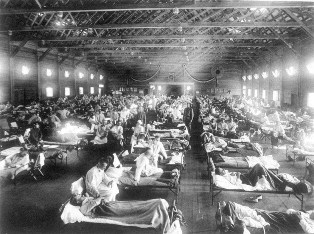
 |
| News & Outreach |
|
||||||
Global Health MattersJanuary - February, 2008 | Volume 7, Issue 1
Summer Flu Outbreak of 1918 May Have Provided Partial Protection Against Lethal Fall PandemicRecent studies of the 1918 Spanish Flu pandemic have dramatically altered scientists’ understanding of its transmission and could provide insight into planning for future pandemics, according to a recent study co-authored by a Fogarty scientist. A summer wave of influenza may have provided partial protection against the lethal fall wave of the 1918 Influenza pandemic in Copenhagen, Denmark, according to the analysis published recently in the Journal of Infectious Diseases.  The 1918 Spanish Flu Epidemic killed over 50 million people worldwide. Photo: WHO The Spanish Flu pandemic killed over 50 million people worldwide. Historical records suggest that an early pandemic wave struck Europe during the summer of 1918. The researchers obtained surveillance data that were compiled weekly in Copenhagen and included medically treated influenza-like illnesses, hospitalizations and deaths by age. The study team, including Fogarty scientist Cécile Viboud, report only .02 percent of Copenhagen’s population died during the summer wave, as compared with .27 percent during the fall wave. Similar patterns were observed in three other Scandinavian cities and likely represent a wider European or even global experience, the study suggests. The Copenhagen summer wave may have been caused by a precursor pandemic virus that transmitted efficiently—but lacked extreme virulence—according to the authors. They conclude that a mild summer wave of a flu pandemic may be a positive occurrence, because it may afford the population some protection against lethal subsequent waves. Epidemiologic characterization of the summer wave of the 1918 influenza pandemic in Copenhagen: Implications for pandemic control strategies. Andreasen V, Viboud C, Simonsen L. J Infect Dis. 2008 Jan. To access the paper, visit: http://www.journals.uchicago.edu/doi/pdf/10.1086/524065 Should you require Adobe Acrobat for viewing PDFs, current and free accessible plug-ins are available at the Adobe website.
|
|||||||
|